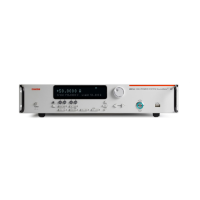Section 7: Command reference Model 2651A High Power System SourceMeter® Instrument Reference Manual
7-360 2651A-901-01 Rev. A / March 2011
Details
The binary representation of data indicates the output pattern that is written to the I/O port. For example, a data
value of 2 has a binary equivalent of 010. Line 2 is set high (1), and the other two lines are set low (0).
Write protected lines are not changed (see tsplink.writeprotect (on page 7-360)).
The reset() function does not affect the present states of the digital I/O lines.
Use the tsplink.writebit() and tsplink.writeport() commands to control the output state of the
synchronization line when trigger operation is set to tsplink.TRIG_BYPASS.
Example
tsplink.writeport(3)
Sets the synchronization Lines 1 and 2 high (binary 011).
Also see
tsplink.readbit() (on page 7-348)
tsplink.readport()
(on page 7-349)
tsplink.writebit()
(on page 7-359)
tsplink.writeprotect
(on page 7-360)
tsplink.writeprotect
This attribute contains the write-protect mask that protects bits from changes by the tsplink.writebit() and
tsplink.writeport() functions.
Type TSP-Link accessible Affected by Where saved Default value
Attribute (RW) Yes Instrument reset
Recall
Saved setups 0
Usage
mask = tsplink.writeprotect
tsplink.writeprotect = mask
mask
An integer that specifies the value of the bit pattern for write-protect; set bits to 1 to
write-protect the corresponding digital I/O line
Details
The binary equivalent of mask indicates the mask to be set for the I/O port. For example, a mask value of 5 has
a binary equivalent 101. This mask write-protects digital I/O lines 1 and 3.
Example
tsplink.writeprotect = 5
Write-protects digital I/O lines 1 and 3.
Also see
Controlling digital I/O lines (on page 3-85)
tsplink.readbit()
(on page 7-348)
tsplink.readport()
(on page 7-349)
tsplink.writebit()
(on page 7-359)
tsplink.writeport()
(on page 7-359)

